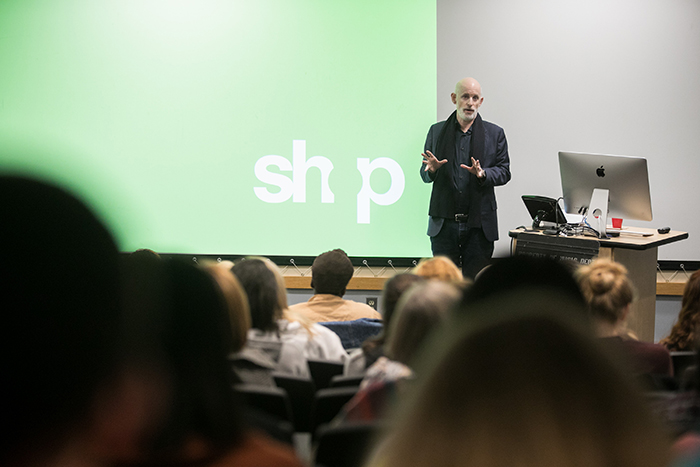SHoP Architects’ Chris Sharples ’87 Creates Experiences, One Structure at a Time

Chris Sharples '87, cofounder of SHoP Architects, designs buildings that aim to shape communities and improve quality of life.
Alumnus shares philosophy behind transformative designs
by MaryAlice Bitts-Jackson
The last time Chris Sharples ’87 stood in the Weiss Center for the Arts lecture hall, he was a graduating senior, defending his thesis and charting an architecture career. Recently, he returned as cofounder and principal architect at SHoP Architects, named Fast Company’s Most Innovative Architecture Firm in the World (2014) and winner of the Smithsonian/Cooper Hewitt National Design Award for Architecture (2009).
Sharples had come to his alma mater to work with students in art & art history classes, offer individualized critiques of senior studio art majors’ work and deliver a public lecture about his career and his mission: to design buildings that help improve communities and community members’ quality of life.
Setting up SHoP
A fine arts major with a minor in political science, Sharples went straight into the graduate architecture program at Columbia University after graduating from Dickinson, earning his degree in 1990. Recognizing a disconnect between the ideas he’d discussed in graduate school and what he encountered in the professional world, he teamed with his twin brother, William, and with friends from Columbia to cofound a new kind of architecture firm that would draw connections between academia and industry—and between architecture, the tech sector, and the social and environmental sciences—using technology to place sustainability, lifestyle and quality-of-life considerations center stage in building design.
SHoP’s first commission was to design an ingenious carousel house in Greenport, New York, that’s now the heart of that town’s waterfront Mitchell Park. Many more megaprojects followed, including a reimagining of NYC’s East River waterfront; the pedestrian-focused 2009 Barclays Center arena in Brooklyn, which features a main concourse at street level; the game-changing Domino Sugar Factory project in Brooklyn; the Midtown Center in Washington, D.C.; and, most recently, Uber’s new headquarters in San Francisco.
Creating ‘a great experience’
For the Uber project, SHoP designed a network of transparent walkways on the outside of the building, which connect every level of the structure. The idea is that employees can see the sidewalk, sky and passersby as they walk from floor to floor, hold walking meetings or set themselves up at one of the many concourse workstations. These common areas are ventilated, rather than air-conditioned, allowing workers to breathe fresh California air while incorporating movement, connection and collaboration into their workdays.
“It’s about creating a great experience,” said Sharples. “This is the only building that does this on such a scale, and it changes the way of life of the people who work there.”
Speaking before a standing-room-only audience in the Weiss Center, Sharples noted that his Dickinson education provided him with a broad-based liberal-arts background that shaped his firm’s approach.
'You students are lucky'
“All of us [SHoP founders] had liberal-arts backgrounds,” he said, noting that the ability to approach problems from different standpoints prepared them to find creative solutions. “The liberal-arts education I received here was very important to how we grew our practice.”
He also noted that while the basic liberal-arts experience remained steadfast in the decades since his graduation, there were also some startling differences.
“I just can’t believe how this program has expanded—it’s something you’d expect to see at the graduate level, not undergraduate,” said Sharples, who has taught at Cornell, Columbia and Yale Universities, Parsons School of Design and the University of Virginia, and now partners with a research institute at Columbia on a solar-energy project. “You students are lucky.”
TAKE THE NEXT STEPS
Published October 31, 2018